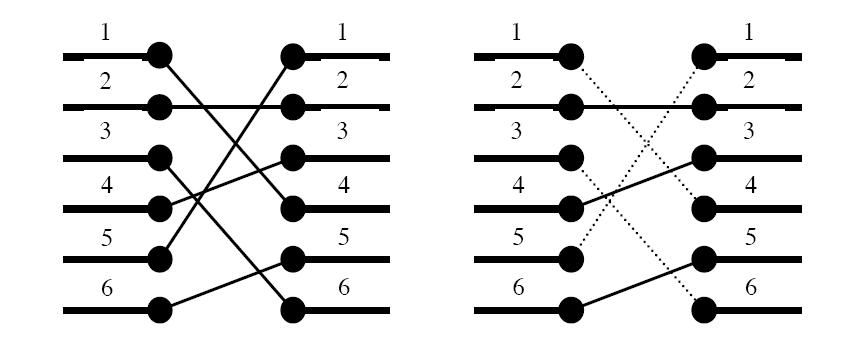【HDU 1950】Bridging signals(LIS算法求最长上升子序列)
2016-07-26 20:25
477 查看
Problem Description
‘Oh no, they’ve done it again’, cries the chief designer at the Waferland chip factory. Once more the routing designers have screwed up completely, making the signals on the chip connecting the ports of two functional blocks cross each other all over the place. At this late stage of the process, it is too expensive to redo the routing. Instead, the engineers have to bridge the signals, using the third dimension, so that no two signals cross. However, bridging is a complicated operation, and thus it is desirable to bridge as few signals as possible. The call for a computer program that finds the maximum number of signals which may be connected on the silicon surface without rossing each other, is imminent. Bearing in mind that there may be housands of signal ports at the boundary of a functional block, the problem asks quite a lot of the programmer. Are you up to the task?
Figure 1.
To the left: The two blocks’ ports and their signal mapping (4,2,6,3,1,5). To the right: At most three signals may be routed on the silicon surface without crossing each other. The dashed signals must be bridged.
A typical situation is schematically depicted in figure 1. The ports of the two functional blocks are numbered from 1 to p, from top to bottom. The signal mapping is described by a permutation of the numbers 1 to p in the form of a list of p unique numbers in the range 1 to p, in which the i:th number pecifies which port on the right side should be connected to the i:th port on the left side.
Two signals cross if and only if the straight lines connecting the two ports of each pair do.
Input
On the first line of the input, there is a single positive integer n, telling the number of test scenarios to follow. Each test scenario begins with a line containing a single positive integer p<40000, the number of ports on the two functional blocks. Then follow p lines, describing the signal mapping: On the i:th line is the port number of the block on the right side which should be connected to the i:th port of the block on the left side.Output
For each test scenario, output one line containing the maximum number of signals which may be routed on the silicon surface without crossing each other.Sample Input
46
4
2
6
3
1
5
10
2
3
4
5
6
7
8
9
10
1
8
8
7
6
5
4
3
2
1
9
5
8
9
2
3
1
7
4
6
Sample Output
39
1
4
题目大意
题目大概意思就是修路问题,要求左右两边修路,并且路不能有交叉,题目保证左右两边有一边是有序的,求最多能修几条路。思路
因为一边保证有序,所以只要求另一边的最长上升子序列就好了,因为按照最长上升子序列的顺序去修路必定不会出现道路交叉的情况。代码
#include <iostream>
#include <cstdio>
#include <cstring>
#include <algorithm>
using namespace std;
const int maxn=40000+5;
int n,arr[maxn],stack[maxn],len;
int main()
{
int t;
scanf("%d",&t);
while(t--)
{
scanf("%d",&n);
for(int i=1;i<=n;i++)
{
scanf("%d",&arr[i]);
}
stack[1]=arr[1];
len=1;
for(int i=1;i<=n;i++)
{
if(arr[i]>stack[len])
{
stack[++len]=arr[i];
}
else
{
int low=lower_bound(stack,stack+len,arr[i])-stack;
stack[low]=arr[i];
}
}
printf("%d\n",len);
}
return 0;
}
相关文章推荐
- android ListView 记录当前位置 恢复
- 操蛋的Camera V2
- linux文件系统及文件属性
- MVC中Controller中的跳转
- 再谈‘进程’
- 网编基础(2)
- bootstrap3上传特效
- paper 92:Lena与图像处理
- 在 Laravel 5 中使用 Laravel Excel 实现 Excel/CSV 文件导入导出功能
- iOS资源大全中文版
- 超详细JSTL标签 参考手册
- Android控件属性
- Linux常见知识
- paper 91:边缘检测近期最新进展的讨论
- 何教授去雾算法C++实现(调试)
- [Python] 技术贴系列之——Django部署方案简介
- MAC地址特殊规定--设置MAC地址时需要有非法MAC设置判断,否则会导致网卡无法启动
- 最短路算法spfa hdu 1863
- 记录在写学术论文时使用MATLAB制作折线图
- HDOJ 4907 Task schedule【思维】
